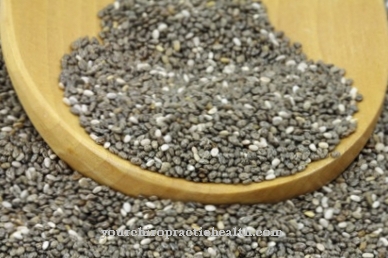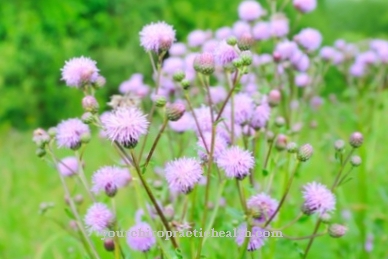The Black cohosh belongs to the buttercup family. It is believed to be helpful against menopausal symptoms.
Occurrence & cultivation of black cohosh

The black cohosh owes its name to its inflorescence. This is reminiscent of a candle. The female root is an herbaceous perennial plant that can reach heights of up to 2.5 meters. The flowering time of the buttercup family is in the months of June and September. The plant has fruits that contain six millimeter long capsules that contain numerous seeds. One of the typical properties of black cohosh is its dark and strong cylindrical rhizome. The large leaves are egg-shaped.
Black cohosh is native to eastern North America and Canada. But it is also found in North Asia and Europe today. The plant prefers the edges of forest areas, light forests, embankments and hedges as locations. It can thrive up to an altitude of 1,500 meters above sea level.
Effect & application
Black cohosh has been used as a medicinal plant since the 18th century. It gained particular importance in gynecology. The North American Indians used them as a tonic for women to treat sciatica, osteoarthritis, rheumatism and snake bites. But the plant was also suitable for the treatment of gynecological diseases or symptoms during the menopause, which is why it was given the name women's root.
In most cases, the Indians administered the plant in the form of a tea. The roots of the black cohosh were boiled from the Iroquois tribe and used as a foot bath. In addition, the herbal remedy was used as a diuretic or to strengthen health. In the 20th century, Western medicine also recognized the positive effects of black cohosh on the reproductive organs of women. When the active ingredients of the medicinal plant were produced synthetically in the 1980s, drugs could finally also be produced.
The positive effect of black cohosh on the ingredients of the plant can be traced back. These can be found in their rootstock. The female root contains triterpene glycosides such as cimifugoside and actein. Furthermore, flavonoids such as formononetin, cimicifugic acid and phenol carboxylic acids belong to the ingredients of the medicinal plant.
The active ingredients of black cohosh have the property of positively influencing the messenger substances of the nervous system. They also affect the bonds that exist on the estrogen receptors. The positive effect of the medicinal plant has been demonstrated in clinical studies. However, the first effect takes two to six weeks. According to recent research, it is also possible to brake hormonally induced hair loss with black cohosh. Furthermore, the sap can be used as a protection agent against insects.
The black cohosh has the property of having a positive effect on the pituitary gland. This leads to a change in the hormone level in the woman's body. This has an effect on the concentration of the hormones FSH (follicle-stimulating hormone) and LH (luteinizing hormone), which are decisive for the female cycle. Since the black cohosh also has an influence on the formation of prolactin, it also stimulates the production of breast milk.
The dried rhizome of black cohosh is of medicinal importance. For use, the rootstocks, which reach a length of 4 to 12 centimeters, are excavated every summer. They are then washed and dried. For medical use, black cohosh is given in the form of preparations containing extracts. These are available in the pharmacy as tablets or drops.
The recommended daily dose of the herbal product is 40 milligrams. In contrast to numerous other medicinal plants, black cohosh is usually not taken as a tea preparation. In principle, it is advisable to consult a doctor before taking. In this way, the gynecologist can decide whether it makes sense to use the product.
Importance for health, treatment & prevention
Black cohosh is used primarily for medical purposes against women's ailments such as menstrual cramps, premenstrual symptoms and menopausal problems. But the medicinal plant can also be used against rheumatic diseases, osteoporosis (bone loss) or bronchial asthma.
It is sensible to take the woman's root for menopausal symptoms such as sweats and hot flashes. The same goes for nervous irritability, anxiety and sleep problems. The ingredients of black cohosh can also be combined with St. John's wort. It is recommended not to take the herbal product for more than six months.
Homeopathy also uses the roots of black cohosh to treat women's ailments. The homeopathic remedy bears the name Cimicifuga racemosa and has beneficial effects on the uterus and ovaries. In addition, it should make childbirth easier and help against irregular contractions. If the symptoms worsen in the cold, but improve in the warm, the remedy is the right one, according to homeopaths.Basically, black cohosh is considered to be well tolerated when used. However, they are not recommended during pregnancy and breastfeeding. In addition, there is a risk of side effects. So stomach problems occasionally occur. If the patient suffers from uterine cancer, black cohosh may only be consumed under the supervision of a doctor. Furthermore, weight gain and damage to the liver are possible.

























.jpg)


